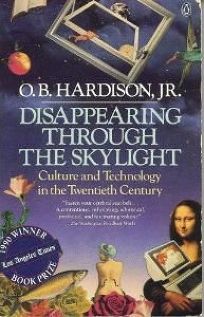It’s a brave new world out there. Factory workers are made of metal and plastic; money, an increasingly abstract proposition, is made and lost not in workshops and fields but on flickering screens; databases grind through a million mainframes, assembling your biography and mine to a fantastic degree of detail; food is synthetic, and only dinosaurs lack microwave ovens in which to nuke it to edibility; half the country can’t place the Soviet Union on a map but can direct-dial a telephone number in Moscow in a minute’s time. The electronic age is upon us, and we are scarcely able to fathom the enormous changes it portends.
O.B. Hardison, Jr. wants to help. A professor of English literature, like the clairvoyant Hugh Kenner and Marshall McLuhan, and former director of the Folger Shakespeare Library, Hardison has now set up shop as a futurist. He is excited by the effects of all this newfangled technology on the arts—and on our culture, our souls.
His new book, Disappearing Through the Skylight, abounds in that excitement, and, if Hardison bites off more than he or his readers can comfortably chew, he does not apologize for it. Instead, he takes us on a whirlwind tour of the history of the future—that is, of 20th-century developments leading to today’s electronic wonderland—that dizzyingly spins from subject to subject: architectural semantics, artificial intelligence, mathematical biology, the Dada movement in the arts, and the politics of the machine. The result is an often incoherent but thought-provoking excursion into the new and unknown.
Technology, Hardison writes, can be a liberating force, freeing workers from the drudgery of the assembly line and double-entry bookkeeping. (He does not, however, go on to say that technological advantages are generally held by the very few, nor that all the timesaving machines surrounding us have increased the typical American workweek from forty to sixty hours.) It is also a universalizing power, one that subtly erases the differences between, say, a Holiday Inn in Schenectady and one in Singapore. (Daniel Boorstin complained about the process thirty years ago in The Image: the same sunlamp in the bathrooms, the same chocolate on the pillows, the same paper umbrellas in the same green drinks.) Independent of cultural values, the new technology permits a McDonald’s hamburger restaurant to arise near Gorky Park, a Madonna video to entertain children in Dar es Salaam.
Its universalizing force can diminish differences between human beings as well, perhaps lessening their individuality and certainly compromising their value in the economic machine. Thanks to the new technology, it is now cheaper for Ford Motors to manufacture some car parts in Korea, others in the Philippines, and still others in Brazil, all to be assembled on the Mexican border; it is now more cost-effective for an American airline company to process tickets for a New York-to-Chicago direct flight in computerized offices in Ireland and the Lesser Antilles. Given no shortage worldwide of cheap labor and easy technological access to it, small wonder that American workers are scrambling to keep even something of the standard of living they enjoyed ten years ago.
But for Hardison these are passing matters, since he is more interested in exploring how scientific ideas penetrate popular culture than in considering the displacements they may cause, the shock waves they may send off. A century ago, John Rockefeller, having caught wind of Darwin along with the rest of the industrialized world, was fond of saying, “The growth of a large business is merely the survival of the fittest.” Today, words like megabyte and parameter fill the air, bandied about by citizens in white lab coats and mechanic’s overalls—and also, Hardison points out, by artists and writers, for whom it was not so long ago fashionable to shun any contact with the new and metallic.
Here Hardison shines. In the late 19th century, he notes, French writers all but rose up in arms over the Eiffel Tower, an engineering feat that, Alexandre Dumas protested, “even the commercial America would reject.” Today their Parisian counterparts exalt the glass pyramid that fronts the Louvre, speak adoringly of the plastic and metal playhouse that is the Centre Pompidou. T.S. Eliot’s The Waste Land, written during the First World War, is “an expression of bafflement; a kind of silence, you might say,” in the face of technological horror; today our required reading is Philip K. Dick’s Do Androids Dream of Electric Sheep? and Umberto Eco’s Foucault’s Pendulum, whose secret hero is a personal computer.
The arts are no longer predominantly modernist, opposed to technology, reliant on individual craft, informed by the classical European past. They are modern, often collectively produced, generated by word processors or light pens, ahistoric. Hardison seems to think this condition is well and good, that the “disappearances” of artistic and cultural elites “complete the democratization of art begun by Dada.” Anyone, he seems to be saying, can be an artist—provided, he does not add, that the right technological goodies, still expensive enough to keep them a province of political and financial elites, are at hand.
Hardison’s vision of an exotically happy future, populated by intelligent robots and electronic artists, full of interactive novels and vaulting skyscrapers, will not be to everyone’s taste; and in any event, the jury is still out on whether such trifles as global deforestation will throw a monkey wrench into the works. His book, punctuated by one gee-whiz after another, is nonetheless provocative reading, if only because it demonstrates so clearly how closely linked once separate worlds—the arts, finance, languages, politics, and technology—have now become. The question remains whether what we think of as the best of our present culture will indeed disappear through the skylight, or simply sink into a glittering mire.
[Disappearing Through the Skylight: Culture and Technology in the Twentieth Century, by O.B. Hardison, Jr. (New York: Viking Press) 389 pp., $22.95]

Leave a Reply